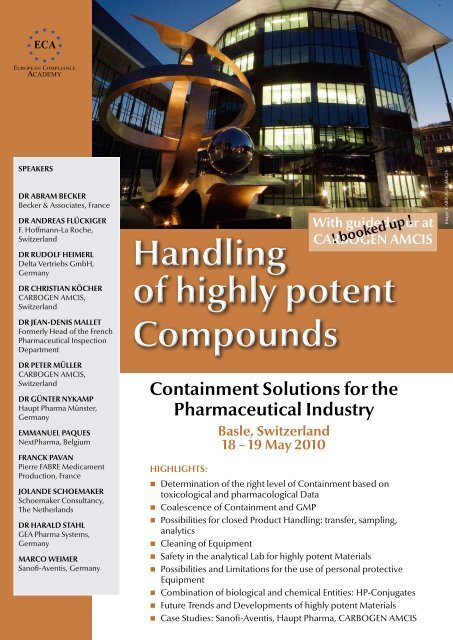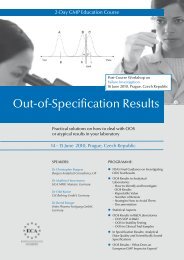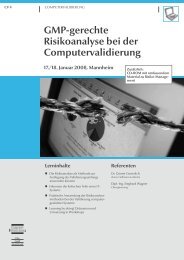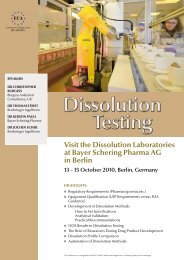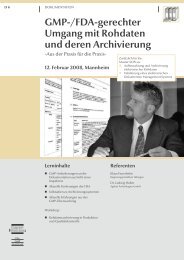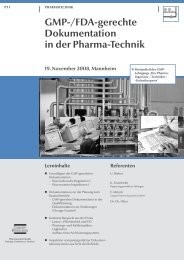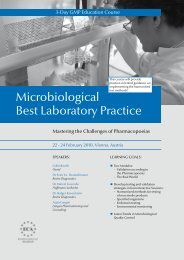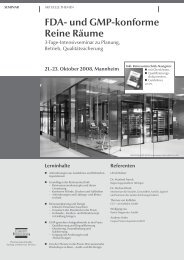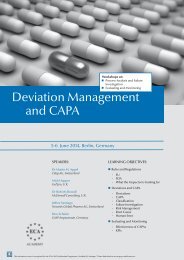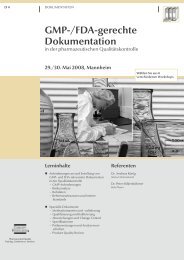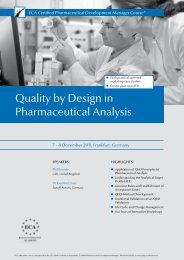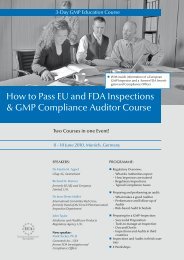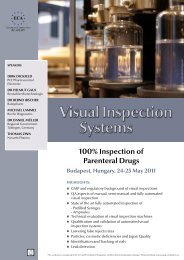Handling of highly potent Compounds Handling of highly potent ...
Handling of highly potent Compounds Handling of highly potent ...
Handling of highly potent Compounds Handling of highly potent ...
Create successful ePaper yourself
Turn your PDF publications into a flip-book with our unique Google optimized e-Paper software.
ECA<br />
EUROPEAN COMPLIANCE<br />
ACADEMY<br />
sPeAkers<br />
Dr AbrAm becker<br />
Becker & Associates, France<br />
Dr AnDreAs Flückiger<br />
F. H<strong>of</strong>fmann-La Roche,<br />
Switzerland<br />
Dr ruDolF Heimerl<br />
Delta Vertriebs GmbH,<br />
Germany<br />
Dr cHristiAn köcHer<br />
CARBOGEN AMCIS,<br />
Switzerland<br />
Dr JeAn-Denis mAllet<br />
Formerly Head <strong>of</strong> the French<br />
Pharmaceutical Inspection<br />
Department<br />
Dr Peter müller<br />
CARBOGEN AMCIS,<br />
Switzerland<br />
Dr günter nykAmP<br />
Haupt Pharma Münster,<br />
Germany<br />
emmAnuel PAques<br />
NextPharma, Belgium<br />
FrAnck PAvAn<br />
Pierre FABRE Medicament<br />
Production, France<br />
JolAnDe scHoemAker<br />
Schoemaker Consultancy,<br />
The Netherlands<br />
Dr HArAlD stAHl<br />
GEA Pharma Systems,<br />
Germany<br />
mArco Weimer<br />
San<strong>of</strong>i-Aventis, Germany<br />
<strong>Handling</strong><br />
<strong>of</strong> <strong>highly</strong> <strong>potent</strong><br />
<strong>Compounds</strong><br />
containment solutions for the<br />
Pharmaceutical industry<br />
basle, switzerland<br />
18 – 19 may 2010<br />
HigHligHts:<br />
With guided tour at<br />
cArbogen Amcis<br />
! booked up !<br />
Determination <strong>of</strong> the right level <strong>of</strong> Containment based on<br />
toxicological and pharmacological Data<br />
Coalescence <strong>of</strong> Containment and GMP<br />
Possibilities for closed Product <strong>Handling</strong>: transfer, sampling,<br />
analytics<br />
Cleaning <strong>of</strong> Equipment<br />
Safety in the analytical Lab for <strong>highly</strong> <strong>potent</strong> Materials<br />
Possibilities and Limitations for the use <strong>of</strong> personal protective<br />
Equipment<br />
Combination <strong>of</strong> biological and chemical Entities: HP-Conjugates<br />
Future Trends and Developments <strong>of</strong> <strong>highly</strong> <strong>potent</strong> Materials<br />
Case Studies: San<strong>of</strong>i-Aventis, Haupt Pharma, CARBOGEN AMCIS<br />
Image: CARBOGEN AMCIS
objectives<br />
background<br />
target Audience<br />
moderator<br />
social event<br />
This event aims at examining the state <strong>of</strong> the art in the currently widely discussed field <strong>of</strong><br />
containment. It will deal with the calculation <strong>of</strong> limits, the possibilities <strong>of</strong>fered by containment<br />
technology and the connections <strong>of</strong> cGMPs with safety aspects.<br />
Due to the increasing number <strong>of</strong> very <strong>potent</strong> and toxic ingredients the manufacture <strong>of</strong> pharmaceutical<br />
products and APIs is more and more becoming a challenge. In addition to the<br />
already well known GMP requirements relative to product protection manufacturers now<br />
also have to adhere to employee protection requirements. However, can GMP and job safety<br />
requirements be combined? It is safe to say that the meaning <strong>of</strong> cross-contamination prevention<br />
during the handling <strong>of</strong> <strong>highly</strong> <strong>potent</strong> materials gained a complete new dimension.<br />
Another issue has been raised by EMA and is still under discussion: the decision whether or<br />
not dedicated facilities will be made mandatory for certain substances. From the industry’s<br />
perspective this decision should only be based on a scientific risk analysis.<br />
Image: Haupt Pharma<br />
During this conference the following questions represent some <strong>of</strong> the issues discussed:<br />
How are iOEL Limits calculated?<br />
How much containment do I need?<br />
What are the different technical solutions?<br />
What should a risk analysis contain?<br />
Which kind <strong>of</strong> zone and layout concepts are reasonable?<br />
How are exposition measurements carried out?<br />
What has to be considered for the cleaning <strong>of</strong> equipment?<br />
What can a lab environment look like for <strong>highly</strong> <strong>potent</strong> materials?<br />
How will the field <strong>of</strong> <strong>highly</strong> active materials develop in the future?<br />
Well established examples for layout concepts, equipment for closed product handling and<br />
analytics are demonstrated through case studies with different pharmaceutical applications<br />
in primary, secondary and R&D facilities.<br />
Managers and technical experts from production, development and occupational health &<br />
safety responsible for the handling <strong>of</strong> <strong>highly</strong>- <strong>potent</strong> APIs, intermediates and drugs.<br />
Further target groups are engineers who design, install and qualify containment systems.<br />
Dr Harald Stahl, GEA Pharma Systems, Germany<br />
Image: CARBOGEN AMCIS<br />
On 18 May 2010 you are cordially invited to a social event. This is an excellent opportunity to<br />
share your experiences with colleagues from other companies in a relaxed atmosphere.
Programme<br />
Principles <strong>of</strong> Assessing and managing occupational Health risks in Potent<br />
compound <strong>Handling</strong><br />
Legal requirements regarding worker safety<br />
Assessing the hazard: potency and toxicity <strong>of</strong> the compounds. Occupational<br />
exposure limits and health hazard categories<br />
Ensuring the right level <strong>of</strong> process containment: Design exposure limits as drivers<br />
for equipment selection. The illusion <strong>of</strong> “closed processes”.<br />
Dedicated facilities or risk-based acceptance <strong>of</strong> multi-purpose manufacturing?<br />
Exposures to pharmaceuticals at the workplace must be controlled to below acceptable<br />
limits. For most APIs, the manufacturer himself needs to develop these limits<br />
and compliance with them must be documented. Protection <strong>of</strong> the workers from<br />
overexposure must be achieved primarily by technical means and not by means <strong>of</strong><br />
personal protective equipment. Equipment must have adequate containment so<br />
that the required exposure control is ensured at least in all routine situations. Existing<br />
facilities must be upgraded accordingly. The toxicological and pharmacological basis<br />
<strong>of</strong> assessing APIs with the objective <strong>of</strong> worker protection is the same as the one justifying<br />
GMP cleaning validation criteria and acceptance <strong>of</strong> multi-product use <strong>of</strong> a facility.<br />
gmP Aspects <strong>of</strong> containment<br />
Historical GMP requirements on containment<br />
Current situation and possible approaches. The Q9-Q10 contribution<br />
Is cross-contamination the only issue ? What about the biological risks ?<br />
How GMP is affected in case <strong>of</strong> defective containment ?<br />
Case study : techniques used to manufacture betalactam and non-betalactam<br />
products in the same building<br />
review <strong>of</strong> technical requirements for contained product handling<br />
Product transfer- review <strong>of</strong> current possibilities<br />
Sampling 1 - Review <strong>of</strong> possibilities for contained sampling<br />
Sampling 2 - Examples for in-line measurements allowing to drop sampling<br />
Cleaning- Examples <strong>of</strong> automatic cleaning<br />
Personal Protective equipment in APi environment: Possibilities and limitations<br />
From Respiratory Protection up to Individual Containment<br />
Requirements on Construction and Building Services<br />
Regulatory Affairs<br />
Occupational Health Requirements<br />
Cost Comparison <strong>of</strong> different Personal Protective Equipment<br />
Performance Comparison <strong>of</strong> Commonly Used PPE<br />
Protecting Operator and Product: A new Approach<br />
Brief Practical Demonstration <strong>of</strong> an Individual Containment<br />
Highly Potent APis: Focus on Analytics and cleaning <strong>of</strong> equipment<br />
Analyzing different types <strong>of</strong> <strong>highly</strong> <strong>potent</strong> APIs (daily doses per determination)<br />
Safety in the analytical lab for <strong>highly</strong> <strong>potent</strong> APIs<br />
Exposure and the special case <strong>of</strong> women <strong>of</strong> childbearing age<br />
Partially dedicated production equipment: Importance <strong>of</strong> and approaches to<br />
cleaning<br />
Cleaning validation and analytical requirements<br />
Controlling carry-over and analytical requirements<br />
Conclusion: Safety <strong>of</strong> patients and workers<br />
the future <strong>of</strong> high-<strong>potent</strong> APis<br />
Introduction<br />
Sources <strong>of</strong> B&A data<br />
Classification<br />
Overview & statistic <strong>of</strong> launched HP-APIs<br />
Overview, statistic & examples <strong>of</strong> clinical Low dosage/toxic HP-APIs<br />
Key drivers to move towards high-<strong>potent</strong> drugs<br />
Potential therapeutic areas for HP-APIs<br />
Conclusion
Programme (cont.)<br />
guided tour on 20 may 2010<br />
cArbogen Amcis Ag<br />
Headquarters –<br />
bubendorf, switzerland<br />
booked up<br />
case study Haupt Pharma: innovative containment Production Design for the<br />
manufacture <strong>of</strong> Highly Potent solid Dosage Forms<br />
Pilot- and commercial-scale production <strong>of</strong> <strong>highly</strong> <strong>potent</strong> oral solid dosage forms<br />
applying state <strong>of</strong> the art containment technologies at Haupt Pharma Münster<br />
"Customized to the needs"-concepts for rooms and equipment<br />
Utilization <strong>of</strong> appropriate containment technologies like isolators, V-processors,<br />
high containment tablet presses and closed containment equipment during the<br />
production chain<br />
case study san<strong>of</strong>i-Aventis: A multipurpose r&D area for <strong>highly</strong> <strong>potent</strong> drugs:<br />
design, construction, commissioning.<br />
Layout<br />
<strong>Handling</strong> systems<br />
RABS and isolator<br />
Material and personnel flow<br />
Pro<strong>of</strong>ing a save environment: SMEPAC<br />
new generation isolators for freeze dried products with AteX compliance<br />
approach<br />
1991 to 2000: first generation <strong>of</strong> isolators: technical characteristics<br />
After 2000: second generation <strong>of</strong> isolators: different objectives – technical<br />
difference<br />
Nowadays: new generation <strong>of</strong> isolators: ATEX standard<br />
manufacturing <strong>of</strong> <strong>highly</strong> <strong>potent</strong> drugs for clinical trials : a practical approach<br />
Analysis <strong>of</strong> the toxicity <strong>of</strong> the APIs<br />
Evaluation <strong>of</strong> the Exposure Potential<br />
Determination <strong>of</strong> the Protection levels for the operators.<br />
case study: A biosafety level 3 Pilot containment Facility for biologicals<br />
Facility design<br />
Segregation <strong>of</strong> live and inactivated organisms<br />
<strong>Handling</strong> personnel flow<br />
<strong>Handling</strong> multiple products in the same facility<br />
Containment and prevention <strong>of</strong> cross-contamination as a quality system<br />
manufacture <strong>of</strong> HP-conjugates (Drug substance): considerations on Process<br />
Development and scale-up"<br />
HP Conjugates: Particular considerations for HP compounds attached to biologics<br />
and polymers<br />
Issues to be considered upon process development (HP conjugates) and<br />
regarding infrastructure<br />
Implementation <strong>of</strong> a large-scale HP plant in India<br />
Bubendorf facility was opened in 1987 and has seen a number <strong>of</strong> additions in its<br />
more than 20-year history. The manufacturing building was commissioned in 1996<br />
and the lab, administration and containment facilities were opened in 2005. The<br />
site now supports 180 employees, who focus on process optimization and supply<br />
<strong>of</strong> late-phase and commercial Active Pharmaceutical Ingredients (API) supplies.<br />
In addition to four process research and development laboratories our state-<strong>of</strong>-<br />
the-art infrastructure in Bubendorf includes manufacturing capabilities for small<br />
batch sizes <strong>of</strong> up to 10 -15 kg.<br />
The specialized laboratories and kilo-scale manufacturing equipment are designed<br />
based on a containment concept utilizing the “split-butterfly valve” and barrier<br />
isolation technology as well as a strict zone concept with pressure cascades, airlocks<br />
and access controls. This allows the safe handling <strong>of</strong> <strong>highly</strong>-<strong>potent</strong> compounds<br />
<strong>of</strong> all categories including cytostatics / and category IV compounds (OEL <<br />
1 µg/m³), the highest category in the CARBOGEN AMCIS categorization system.<br />
During the tour you will see the <strong>highly</strong> active production area, the analytical<br />
laboratories for high actives, flexible containment solutions and you will get<br />
insight to containment in india.<br />
**Please understand that due to a competitive situation some delegates may not<br />
be granted access to the site.**
speakers<br />
Dr AbrAm becker, Becker & Associates<br />
D.Sc. College de France, Scientific director (pharmaceutical companies.) Author & Editor <strong>of</strong><br />
Future generics -the life science encyclopedia. Director <strong>of</strong> Becker & Associates.<br />
Dr AnDreAs Flückiger, F. H<strong>of</strong>fmann-La Roche AG<br />
An occupational physician by training, Andreas Flückiger has been the head <strong>of</strong> the occupational<br />
health services <strong>of</strong> the Roche Group for 20 years. He is active in leading roles in numerous<br />
national and international associations such as the International Association for Occupational<br />
and Environmental Health in the Chemical Industry (Medichem), in the Scientific<br />
Committee <strong>of</strong> the European Council for Ecotoxicology and Toxicology <strong>of</strong> Chemicals (ECE-<br />
TOC).<br />
Dr ruDolF Heimerl, Delta Vertrieb GmbH<br />
Dr Heimerl studied biology and holds a doctoral degree in virology from the Ludwig-Maximilians-University<br />
<strong>of</strong> Munich. He is working for Delta Vertrieb GmbH since 1994 in various managing<br />
positions. He is now head <strong>of</strong> the research and development department.<br />
Dr cHristiAn köcHer, CARBOGEN AMCIS AG<br />
Christian Köcher holds a PhD in chemistry and an Executive MBA degree from the University<br />
<strong>of</strong> Zürich. He worked for a manufacturer <strong>of</strong> generic APIs before joining CARBOGEN AMCIS.<br />
He has worked on early- and late-phase projects as a PR&D Chemist, Group Leader, Manager<br />
PR&D and currently as Project Manager. He is focused on projects dealing with hp compounds<br />
and process validation.<br />
Dr JeAn-Denis mAllet, International Committee Red Cross<br />
Jean-Denis Mallet is a doctor pharmacist, graduated in technological pharmacy and management.<br />
He is currently a GMP auditor within the International Committee <strong>of</strong> the Red Cross. He<br />
was previously the Head <strong>of</strong> the Pharmaceutical Inspection Department at the French Health<br />
Products Regulatory Agency (AFSSAPS). He also used to work in or with the pharmaceutical<br />
industry at various positions including QA, Production, Engineering and GMP Consulting.<br />
Dr Peter müller, CARBOGEN AMCIS AG<br />
Peter M. Mueller did his PhD-thesis at ETHZ and worked for 2 years at MIT, for 10 years in Roche<br />
Basel's medicinal chemistry and CNS-pharmacology research, and for 10 years as head <strong>of</strong><br />
R+D <strong>of</strong> Roche's fragrances, flavors and cosmetics division. He left Roche in 1995 and soon was<br />
C.O.O. <strong>of</strong> AMCIS AG Bubendorf. Today, he is consultant and one <strong>of</strong> CARBOGEN AMCIS' key<br />
experts regarding containment and <strong>highly</strong> <strong>potent</strong> APIs.<br />
Dr günter nykAmP, Haupt Pharma Münster GmbH<br />
Dr Nykamp is a pharmacist and holds master and doctoral degrees in pharmaceutics and<br />
pharmaceutical technology resp.. He is in charge <strong>of</strong> the manufacturing and formulation development<br />
departments at Haupt Pharma Muenster.<br />
emmAnuel PAques, NextPharma<br />
Mr Paques is Development Director, working in the Sterile Products Development Center at<br />
NextPharma, Braine-l’Alleud, Belgium. He is Industrial Pharmacist by training with a degree in<br />
pharmaceutical technology and industrial production. He is working in the sterile production<br />
for more than 30 years and has a large experience in cytostatic production and lyophilisation.<br />
FrAnck PAvAn, Pierre FABRE Medicament Production<br />
Franck Pavan in an engineer in Biochemistry. After working as plant manager in sterile manufacturing,<br />
he is now working for Pierre Fabre Medicament Production in France. First as an Industrial<br />
Development Manager and Cytotoxic Production Manager and also Project leader for<br />
the Taxotere Project, today in the position as Outsourcing Business Development Manager.<br />
JolAnDe scHoemAker, Schoemaker Consultancy<br />
Jolande Schoemaker works as a consultant to the pharmaceutical industry. Previous she was<br />
the Director Quality Affairs at Crucell. Jolande gained a wide field <strong>of</strong> experience in many aspects<br />
<strong>of</strong> the pharmaceutical and biotechnology industry, including formulation <strong>of</strong> drugs, manufacturing<br />
<strong>of</strong> sterile pharmaceutical products, clinical trials, Regulatory Affairs, Quality Control<br />
and Quality Assurance. Furthermore, she was involved in many regulatory inspections.<br />
Dr HArAlD stAHl, GEA Pharma Systems<br />
Harald Stahl worked for the Pharmaceutical Development <strong>of</strong> Schering AG in Germany. Since<br />
1995 he served within GEA Process Technology in various positions. Presently he owns the position<br />
<strong>of</strong> a Senior Pharmaceutical Technologist <strong>of</strong> GEA Pharma Systems. He has published<br />
more than 20 papers on various aspects <strong>of</strong> pharmaceutical production.<br />
mArco Weimer, San<strong>of</strong>i-Aventis Deutschland GmbH<br />
Marco Weimer is currently Head <strong>of</strong> Pharmaceutical Engineering in the Pharmaceutical Sciences<br />
Department at San<strong>of</strong>i-Aventis in Frankfurt. He holds degrees in Pharmaceutical engineering<br />
and Process engineering.
easy registration<br />
<br />
reservation Form:<br />
concePt HeiDelberg<br />
P.o. box 10 17 64<br />
69007 Heidelberg<br />
germany<br />
Date<br />
Tuesday, 18 May 2010, 09.00 – 18.30 h<br />
(Registration and c<strong>of</strong>fee 08.30 – 09.00 h)<br />
Wednesday, 19 May 2010, 08.30 – 17.45 h<br />
The guided tour at the CARBOGEN AMCIS site will take place on<br />
Thursday, 20 May. There will be a transfer from the hotel to<br />
CARBOGEN AMCIS and back to the hotel after the tour. The Bus<br />
will arrive at approx. 13.30 h at the hotel.<br />
booked up<br />
venue<br />
Ramada Plaza Basel<br />
Messeplatz 12<br />
4058 Basle, Switzerland<br />
Tel. +41 (0)61 560 4000<br />
Fax +41 (0)61 560 55 55<br />
reduced Fees - conference only, without guided tour at<br />
carbogen<br />
Non-ECA Members EUR 1,690.- per delegate plus VAT<br />
ECA Members EUR 1,521- per delegate plus VAT<br />
APIC Members EUR 1,606.- per delegate plus VAT<br />
(does not include ECA Membership)<br />
EU GMP Inspectorates EUR 845.- per delegate plus VAT<br />
The conference fee is payable in advance after receipt <strong>of</strong><br />
invoice and includes conference documentation, dinner<br />
on the first day, lunch on both days and all refreshments.<br />
VAT is reclaimable.<br />
If the bill-to-address deviates from the specification<br />
to the right, please fill out here:<br />
CONCEPT HEIDELBERG<br />
P.O. Box 10 17 64<br />
Fax +49 (0) 6221/84 44 34<br />
69007 Heidelberg<br />
Germany<br />
<br />
reservation Form:<br />
+ 49 6221 84 44 34<br />
Accommodation<br />
CONCEPT HEIDELBERG has reserved a limited number <strong>of</strong> rooms in<br />
the conference hotel. You will receive a room reservation form<br />
when you have registered for the conference. Please use this form<br />
for your room reservation or be sure to mention "VA 6377 ECA<br />
Event" to receive the specially negotiated rate for the duration <strong>of</strong><br />
your stay. Reservation should be made directly with the hotel not<br />
later than 19 April 2010. Early reservation is recommended.<br />
conference language<br />
The <strong>of</strong>ficial conference language will be English.<br />
organisation and contact<br />
ECA has entrusted Concept Heidelberg with the<br />
organisation <strong>of</strong> this event.<br />
CONCEPT HEIDELBERG<br />
P.O. Box 10 17 64<br />
69007 Heidelberg, GERMANY<br />
Phone +49 (0) 62 21/84 44-0<br />
Fax +49 (0) 62 21/84 44 34<br />
E-mail: info@concept-heidelberg.de<br />
www.concept-heidelberg.de<br />
For questions regarding content:<br />
Dr Robert Eicher (Operations Director) at +49-62 21/84 44 12 or per<br />
e-mail at eicher@concept-heidelberg.de.<br />
For questions regarding reservation, hotel, organisation etc.:<br />
Ms Marion Weidemaier (Organisation Manager) at +49-62 21/84<br />
44 46 or per e-mail at weidemaier@concept-heidelberg.de.<br />
Reservation Form (Please complete in full)<br />
<strong>Handling</strong> <strong>of</strong> <strong>highly</strong> <strong>potent</strong> compounds (only conference)<br />
Basle, Switzerland, 18–19 May 2010<br />
* Mr * Ms<br />
Title, first name, surname<br />
Company<br />
Department<br />
important: Please indicate your company’s vAt iD number<br />
Please indicate the Purchase order number, if applicable<br />
Street / P.O. Box<br />
City Zip Code<br />
Country<br />
Phone / Fax<br />
E-Mail (Please fill in)<br />
general terms and conditions<br />
If you cannot attend the conference you have two options:<br />
1. We are happy to welcome a substitute colleague at any time.<br />
2. If you have to cancel entirely we must charge the following processing fees: Cancellation<br />
until 2 weeks prior to the conference 10 %,<br />
until 1 weeks prior to the conference 50 %<br />
within 1 week prior to the conference 100 %.<br />
CONCEPT HEIDELBERG reserves the right to change the materials, instructors, or speakers without<br />
notice or to cancel an event. If the event must be cancelled, registrants will be notified as soon as<br />
e-mail: @ info@concept-heidelberg.de internet:<br />
www.gmp-compliance.org<br />
+49 6221 84 44 34<br />
possible and will receive a full refund <strong>of</strong> fees paid. CONCEPT HEIDELBERGwill not be responsible for<br />
discount airfare penalties or other costs incurred due to a cancellation.<br />
terms <strong>of</strong> payment: Payable without deductions within 10 days after receipt <strong>of</strong> invoice.<br />
important: This is a binding registration and above fees are due in case <strong>of</strong> cancellation or nonappearance.<br />
If you cannot take part, you have to inform us in writing. The cancellation fee will then be<br />
calculated according to the point <strong>of</strong> time at which we receive your message. In case you do not appear<br />
at the event without having informed us, you will have to pay the full registration fee, even if you have<br />
not made the payment yet. Only after we have received your payment, you are entitled to participate<br />
in the conference (receipt <strong>of</strong> payment will not be confirmed)!<br />
wh/vers.1/080909


